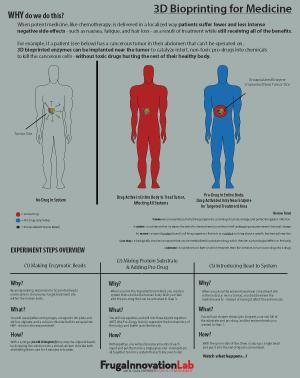
Bioengineers Bring 3D Tech to The Tech
The School of Engineering's Frugal Innovation Lab (FIL) has teamed up with The Tech Museum of Innovation in San Jose, California, and their partners NASDAQ OMX and Accenture to present a series of Social Innovation Workshops showcasing some of the exciting ways technology is being put to good use for social benefit. In four sessions this year, FIL staff and SCU engineering faculty and students create a fun environment of interactive learning in The Tech's basement (which is used to teach all sorts of engineering or tech-based projects) for teenagers to explore topics as varied as sustainable building materials and techniques, solutions for detecting water pathogens, and mobile phone apps that can improve lives of people in disadvantaged communities, locally and globally.
July's workshop focused on 3D Printing for Humanity. Here, 40 teens selected through The Tech’s Young Innovators Scholarship Program participated in a number of hands-on activities, one of which was led by Department of Bioengineering Assistant Professor Prashanth Asuri and students Sabrina Cismas, Jeffrey Kunkel, William Leineweber, Casey O'Brien, and Mallory Williams. Participants were briefed on how engineers are using 3D printing to mitigate the negative side effects of cancer treatment on patients by delivering a pro-drug (a biologically inactive, nontoxic agent that can be metabolized to create a drug) to the entire body and then implanting 3D bioprinted enzymes near the site of the tumor to catalyze the pro-drug into a biologically active chemical compound that will kill the cancerous cells in that particular area without harming the rest of the body.
To demonstrate this concept to the attendees, SCU students created a simplistic rendition of an in vivo system on a laboratory benchtop. "A main goal of the experimental set-up was to mimic tumor site conditions so that students could tangibly grasp the role of enzymes in a targeted drug treatment," said Cismas. Teens were introduced to lab safety guidelines before donning lab coats, gloves, and goggles. Once outfitted, they used tools of the trade (pipettes, syringes, magnetic stir plate, et cetera) to 3D bioprint tiny enzymecontaining alginate beads. Then, in a glass vial meant to represent the human body, they created a substrate, mixing two solutions that characterized the blood and biochemistry of the body with a pro-drug. Finally, using a Slurpee straw, the budding bioengineers spooned a single enzymatic bead into each of their vials. What the students didn't know was that the substrate contained a colorimetric agent, so when they introduced the enzyme bead to the solution containing the pro-drug, the activation of the pro-drug to a drug was immediately apparent when the liquid changed from clear to a blue color.
"The experiment was well received and the kids asked a lot of good questions—some about how this is being done now, which is hard to answer since the process is still in research; but they were engaged and grasping the concept," said Kunkel. Participants took the experiment even further by investigating how outcomes changed by making the beads without the enzyme, and by adjusting the amounts of the various solutions, or experimenting with extrusion of the beads. "I learned I like teaching. They were so happy to learn something new, and it made me happy to see them learning," said O’Brien.
"As the research continues, the applications of this technology will extend well beyond use in chemotherapy," said Asuri. "But for now, we introduced to the students how 3D printing technology could be used to interface biomolecules or biological entities with synthetic materials and the possibilities this could bring to promote human health and medicine."
"The level of subject matter that these middle and high school students are able to engage with is incredible," said Elizabeth Sweeny, FIL director of programs and partnerships, continuing, "What excites us about these workshops is that it gives a direct conduit for students to harness their skills and intellect to build, use, and explore technology for societal benefit."